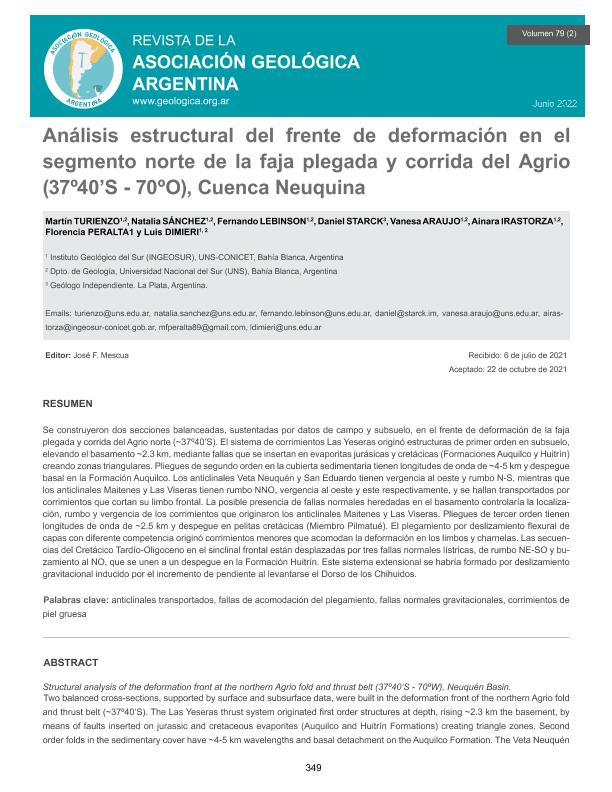Mostrar el registro sencillo del ítem
dc.contributor.author
Turienzo, Martin Miguel

dc.contributor.author
Sánchez, Natalia Paola

dc.contributor.author
Lebinson, Fernando Oscar

dc.contributor.author
Starck, Daniel
dc.contributor.author
Araujo, Vanesa Soledad

dc.contributor.author
Irastorza, Ainara

dc.contributor.author
Peralta, Maria Florencia

dc.contributor.author
Dimieri, Luis Vicente

dc.date.available
2022-07-15T13:42:26Z
dc.date.issued
2021-11
dc.identifier.citation
Turienzo, Martin Miguel; Sánchez, Natalia Paola; Lebinson, Fernando Oscar; Starck, Daniel; Araujo, Vanesa Soledad; et al.; Análisis estructural del frente de deformación en el segmento norte de la faja plegada y corrida del Agrio (37º40?S - 70ºO), Cuenca Neuquina; Asociación Geológica Argentina; Revista de la Asociación Geológica Argentina; 79; 2; 11-2021; 1-32
dc.identifier.issn
1853-7138
dc.identifier.uri
http://hdl.handle.net/11336/162184
dc.description.abstract
Se construyeron dos secciones balanceadas, sustentadas por datos de campo y subsuelo, en el frente de deformación de la faja plegada y corrida del Agrio norte (~37º40?S). El sistema de corrimientos Las Yeseras originó estructuras de primer orden en subsuelo, elevando el basamento ~2.3 km, mediante fallas que se insertan en evaporitas jurásicas y cretácicas (Formaciones Auquilco y Huitrín) creando zonas triangulares. Pliegues de segundo orden en la cubierta sedimentaria tienen longitudes de onda de ~4-5 km y despegue basal en la Formación Auquilco. Los anticlinales Veta Neuquén y San Eduardo tienen vergencia al oeste y rumbo N-S, mientras que los anticlinales Maitenes y Las Viseras tienen rumbo NNO, vergencia al oeste y este respectivamente, y se hallan transportados por corrimientos que cortan su limbo frontal. La posible presencia de fallas normales heredadas en el basamento controlaría la localización, rumbo y vergencia de los corrimientos que originaron los anticlinales Maitenes y Las Viseras. Pliegues de tercer orden tienen longitudes de onda de ~2.5 km y despegue en pelitas cretácicas (Miembro Pilmatué). El plegamiento por deslizamiento flexural de capas con diferente competencia originó corrimientos menores que acomodan la deformación en los limbos y charnelas. Las secuencias del Cretácico Tardío-Oligoceno en el sinclinal frontal están desplazadas por tres fallas normales lístricas, de rumbo NE-SO y buzamiento al NO, que se unen a un despegue en la Formación Huitrín. Este sistema extensional se habría formado por deslizamiento gravitacional inducido por el incremento de pendiente al levantarse el Dorso de los Chihuidos.
dc.description.abstract
Structural analysis of the deformation front at the northern Agrio fold and thrust belt (37º40’S - 70ºW), Neuquén Basin. Two balanced cross-sections, supported by surface and subsurface data, were built in the deformation front of the northern Agrio fold and thrust belt (~37º40’S). The Las Yeseras thrust system originated first order structures at depth, rising ~2.3 km the basement, by means of faults inserted on jurassic and cretaceous evaporites (Auquilco and Huitrín Formations) creating triangle zones. Second order folds in the sedimentary cover have ~4-5 km wavelengths and basal detachment on the Auquilco Formation. The Veta Neuquén and San Eduardo anticlines have west-vergence and N-S trend, while the Maitenes and Las Viseras anticlines have NNW trend, west and east vergence respectively, and both are transported by thrusts that cut their forelimbs. The possible presence of inherited normal faults in the basement would control the location, trend and vergence of thrust originating the Maitenes and Las Viseras anticlines. Third order folds have ~2.5 km wavelengths and a detachment on cretaceous shales (Pilmatué Member). Flexural slip folding of layers with different competence originated minor fold-accommodation thrusts in the limbs and hinges. Late Cretaceous-Oligocene sequences in the frontal syncline are displaced by three lístric normal faults, of NE-SW trend and dipping to the NW, that join to a decollement on the Huitrín Formation. This extensional system would be formed by gravitational gliding induced by the increasing slope caused by the uplift of the Dorso de los Chihuidos.
dc.format
application/pdf
dc.language.iso
spa
dc.publisher
Asociación Geológica Argentina

dc.rights
info:eu-repo/semantics/openAccess
dc.rights.uri
https://creativecommons.org/licenses/by-nc/2.5/ar/
dc.subject
ANTICLINALES TRANSPORTADOS
dc.subject
FALLAS DE ACOMODACIÓN DEL PLEGAMIENTO
dc.subject
FALLAS NORMALES GRAVITACIONALES
dc.subject
CORRIMIENTOS DE PIEL GRUESA
dc.subject.classification
Geología

dc.subject.classification
Ciencias de la Tierra y relacionadas con el Medio Ambiente

dc.subject.classification
CIENCIAS NATURALES Y EXACTAS

dc.title
Análisis estructural del frente de deformación en el segmento norte de la faja plegada y corrida del Agrio (37º40?S - 70ºO), Cuenca Neuquina
dc.type
info:eu-repo/semantics/article
dc.type
info:ar-repo/semantics/artículo
dc.type
info:eu-repo/semantics/publishedVersion
dc.date.updated
2021-12-13T20:40:50Z
dc.identifier.eissn
1851-8249
dc.journal.volume
79
dc.journal.number
2
dc.journal.pagination
1-32
dc.journal.pais
Argentina

dc.journal.ciudad
Buenos Aires
dc.description.fil
Fil: Turienzo, Martin Miguel. Consejo Nacional de Investigaciones Científicas y Técnicas. Centro Científico Tecnológico Conicet - Bahía Blanca. Instituto Geológico del Sur. Universidad Nacional del Sur. Departamento de Geología. Instituto Geológico del Sur; Argentina
dc.description.fil
Fil: Sánchez, Natalia Paola. Consejo Nacional de Investigaciones Científicas y Técnicas. Centro Científico Tecnológico Conicet - Bahía Blanca. Instituto Geológico del Sur. Universidad Nacional del Sur. Departamento de Geología. Instituto Geológico del Sur; Argentina
dc.description.fil
Fil: Lebinson, Fernando Oscar. Consejo Nacional de Investigaciones Científicas y Técnicas. Centro Científico Tecnológico Conicet - Bahía Blanca. Instituto Geológico del Sur. Universidad Nacional del Sur. Departamento de Geología. Instituto Geológico del Sur; Argentina
dc.description.fil
Fil: Starck, Daniel. No especifíca;
dc.description.fil
Fil: Araujo, Vanesa Soledad. Consejo Nacional de Investigaciones Científicas y Técnicas. Centro Científico Tecnológico Conicet - Bahía Blanca. Instituto Geológico del Sur. Universidad Nacional del Sur. Departamento de Geología. Instituto Geológico del Sur; Argentina
dc.description.fil
Fil: Irastorza, Ainara. Consejo Nacional de Investigaciones Científicas y Técnicas. Centro Científico Tecnológico Conicet - Bahía Blanca. Instituto Geológico del Sur. Universidad Nacional del Sur. Departamento de Geología. Instituto Geológico del Sur; Argentina
dc.description.fil
Fil: Peralta, Maria Florencia. Consejo Nacional de Investigaciones Científicas y Técnicas. Centro Científico Tecnológico Conicet - Bahía Blanca. Instituto Geológico del Sur. Universidad Nacional del Sur. Departamento de Geología. Instituto Geológico del Sur; Argentina
dc.description.fil
Fil: Dimieri, Luis Vicente. Consejo Nacional de Investigaciones Científicas y Técnicas. Centro Científico Tecnológico Conicet - Bahía Blanca. Instituto Geológico del Sur. Universidad Nacional del Sur. Departamento de Geología. Instituto Geológico del Sur; Argentina
dc.journal.title
Revista de la Asociación Geológica Argentina

dc.relation.alternativeid
info:eu-repo/semantics/altIdentifier/url/https://revista.geologica.org.ar/raga/article/view/1465
Archivos asociados
